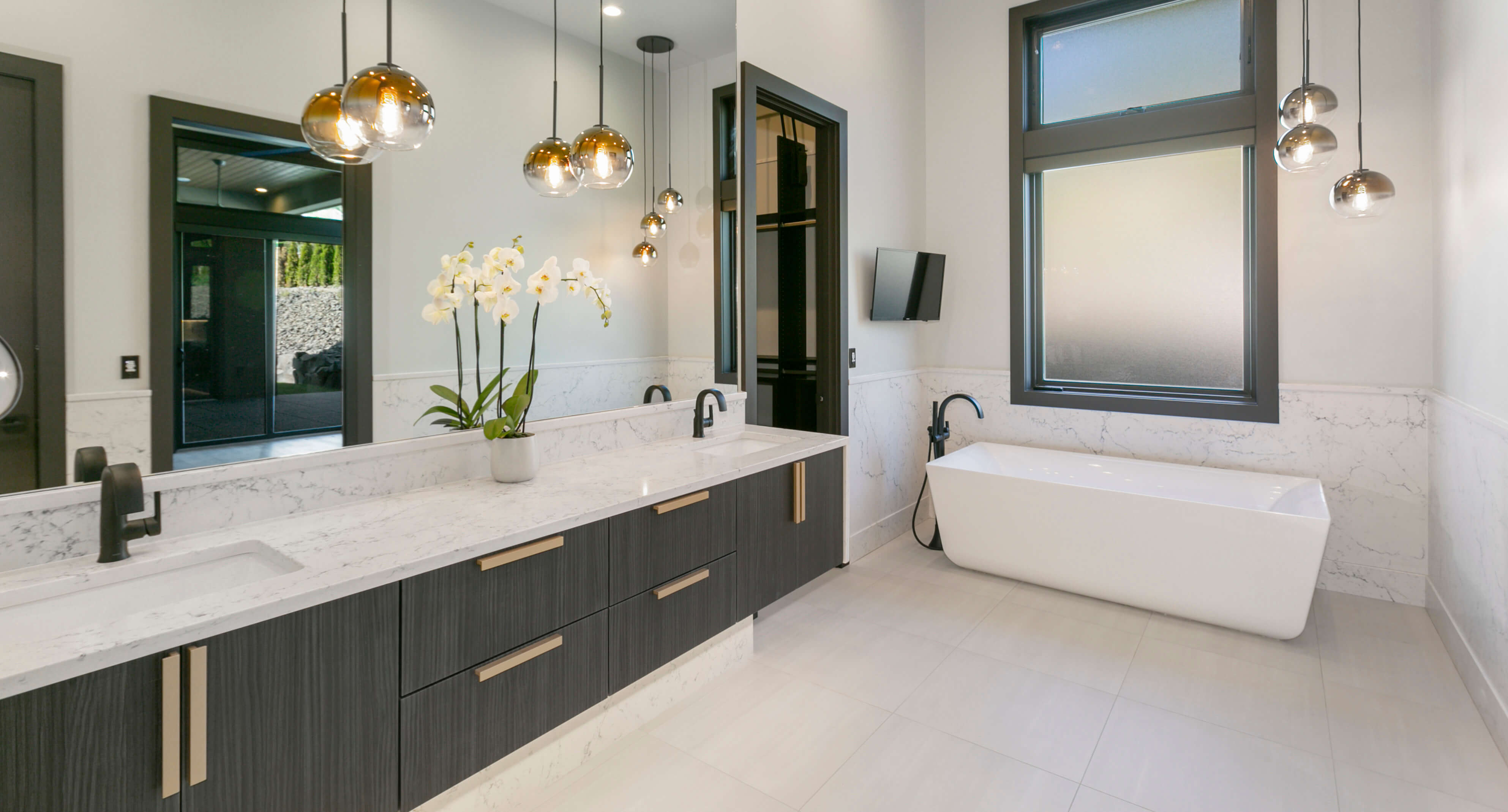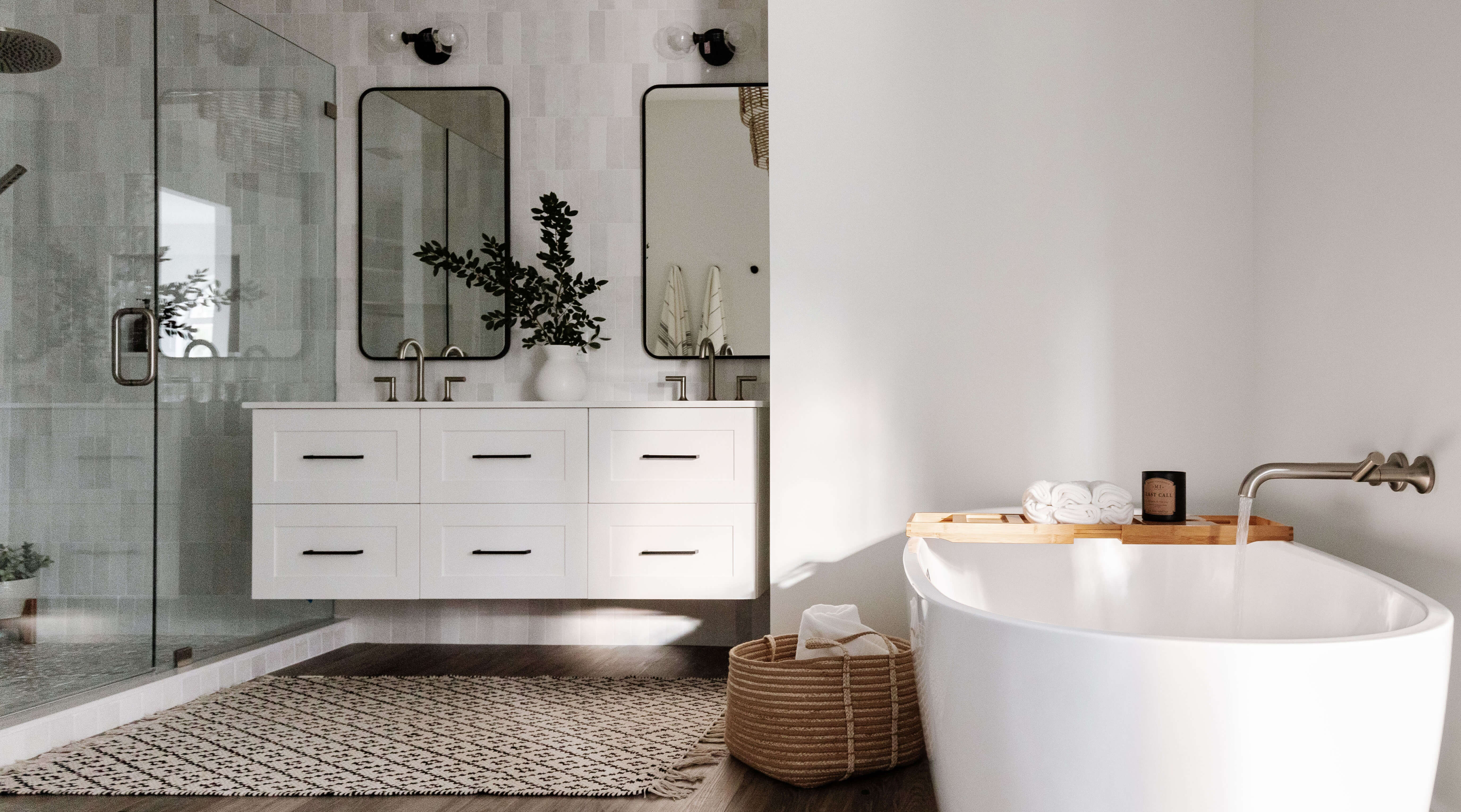The Allure of Rustic Floating Vanities: Rustic Floating Vanity Bathroom

Rustic floating vanities have emerged as a popular choice in bathroom design, blending natural charm with contemporary appeal. These vanities effortlessly enhance the aesthetic of any bathroom, creating a space that feels both inviting and stylish.
The Appeal of Rustic Floating Vanities
Rustic floating vanities are admired for their unique blend of natural charm, space-saving qualities, and contemporary appeal. They effortlessly enhance the aesthetic of any bathroom, creating a space that feels both inviting and stylish.
- Natural Charm: The use of natural materials like reclaimed wood, weathered barnwood, and natural stone infuses the bathroom with a sense of warmth and authenticity, creating a connection to nature.
- Space-Saving Qualities: Floating vanities, unlike traditional vanities, do not require legs or a base, maximizing floor space and creating a sense of openness. This is particularly beneficial in smaller bathrooms, where every inch of space is precious.
- Contemporary Appeal: The clean lines and minimalist design of floating vanities seamlessly integrate with modern bathroom styles, creating a sophisticated and elegant look.
Types of Rustic Materials Used in Floating Vanities, Rustic floating vanity bathroom
Rustic floating vanities offer a diverse range of materials, each contributing a unique aesthetic to the bathroom.
- Reclaimed Wood: Reclaimed wood, salvaged from old barns, factories, or other structures, brings a rich history and character to the bathroom. Its unique knots, grains, and imperfections tell stories of its past life, adding a touch of nostalgia and rustic charm.
- Weathered Barnwood: Weathered barnwood, with its natural patina and distressed finish, evokes a sense of warmth and timelessness. Its unique character and weathered texture add a touch of rustic elegance to the bathroom.
- Natural Stone: Natural stone, such as granite, marble, or slate, brings a touch of sophistication and durability to the bathroom. Its natural patterns and textures create a timeless and elegant aesthetic.
Reclaimed Wood Floating Vanity Design
A reclaimed wood floating vanity can be a stunning focal point in a rustic bathroom.
- Features: The vanity can be crafted from reclaimed wood planks with a natural finish, showcasing the wood’s unique grain patterns and knots. The countertop can be made from a contrasting material like natural stone or concrete, adding a touch of modern sophistication.
- Benefits: Reclaimed wood is an environmentally friendly choice, reducing waste and giving new life to old materials. The natural beauty of the wood creates a warm and inviting ambiance, while its durability ensures long-lasting use.
Creating a Rustic Bathroom Ambiance

A rustic bathroom design should evoke a sense of warmth, comfort, and connection to nature. It’s about creating a space that feels inviting and relaxing, reminiscent of a cozy cabin or a charming farmhouse. A rustic floating vanity serves as a beautiful focal point, but it’s the surrounding elements that truly bring the ambiance to life.
Color Palettes
The color palette of a rustic bathroom should reflect the natural world, incorporating earthy tones and warm hues.
- Earthy Neutrals: Think of shades like beige, brown, gray, and cream. These colors provide a calming backdrop for the other elements in the room.
- Warm Accents: Introduce pops of color with shades like terracotta, rust, olive green, or deep blue. These colors add depth and vibrancy to the space.
- Natural Wood Tones: The wood of the floating vanity should be a key element in the color palette. Consider using wood with a natural finish to highlight its grain and texture.
Lighting
Lighting plays a crucial role in setting the mood of a bathroom. Rustic bathrooms often incorporate a combination of natural and artificial lighting.
- Natural Light: Maximize natural light by using large windows or skylights. If natural light is limited, consider adding a window with a view of nature.
- Warm Artificial Light: Use light bulbs with a warm, yellow tone to create a cozy atmosphere. Consider using pendant lights over the vanity, sconces on the walls, or a chandelier to add a touch of elegance.
- Dimmers: Dimmers allow you to adjust the lighting intensity for different moods. This is especially useful for creating a relaxing ambiance for a bath or shower.
Accessories
Accessories are essential for adding personality and completing the rustic bathroom look.
- Textured Walls: Consider using natural materials like stone or brick for a rustic touch. Alternatively, you can create a textured effect with wallpaper or paint.
- Exposed Beams: If possible, expose the beams in the ceiling to add a rustic element. If not, you can create a faux beam effect with wood panels or molding.
- Vintage Fixtures: Look for vintage fixtures like faucets, towel bars, and light fixtures to add character to the space. These fixtures can often be found at antique shops or online marketplaces.
- Natural Elements: Incorporate natural elements like plants, woven baskets, and wooden trays. These elements add a touch of nature and warmth to the room.
Mood Board Example
Imagine a rustic bathroom with a weathered wood floating vanity. The vanity features a natural finish, highlighting the wood’s grain and texture. The walls are painted in a warm, earthy beige, and the floor is covered in distressed wood planks. A large window provides natural light, and the room is illuminated by a rustic chandelier with exposed bulbs. A woven basket sits on the countertop, filled with fluffy towels. A potted fern adds a touch of greenery, and a vintage mirror hangs above the vanity. The entire space exudes a sense of warmth, comfort, and connection to nature.
Practical Considerations for Rustic Floating Vanities

Rustic floating vanities offer a unique blend of style and functionality, but it’s crucial to weigh their practical aspects before making a decision. While their charm is undeniable, factors like durability, maintenance, and potential moisture issues should be carefully considered.
Installation Process of a Rustic Floating Vanity
Installing a rustic floating vanity requires a combination of carpentry, plumbing, and finishing skills. Here’s a step-by-step guide:
- Prepare the Wall: Ensure the wall is sturdy and level. If necessary, reinforce it with additional support.
- Mark the Mounting Points: Determine the desired height and position of the vanity and mark the wall accordingly.
- Install the Brackets: Attach the mounting brackets to the wall using appropriate screws or anchors.
- Connect the Plumbing: Install the sink and faucet, ensuring proper connections to the water supply and drain lines.
- Secure the Vanity: Carefully hang the vanity on the brackets, ensuring it’s level and securely fastened.
- Finishing Touches: Apply any necessary caulking around the vanity to prevent water damage. Install the cabinet doors and hardware.
Durability and Maintenance of Rustic Floating Vanities
The durability and maintenance requirements of rustic floating vanities vary depending on the chosen materials.
| Material | Pros | Cons |
|---|---|---|
| Wood | Natural beauty, warm feel, customizable | Susceptible to moisture damage, requires regular sealing, prone to scratches |
| Stone | Durable, water-resistant, elegant appearance | Heavy, potentially expensive, cold to the touch |
| Metal | Modern and industrial look, easy to clean, resistant to moisture | Can be susceptible to rust, may require special cleaning products |
Moisture Issues with Rustic Floating Vanities
Moisture is a significant concern with rustic floating vanities, particularly those made from wood.
- Sealing: Applying a sealant to the wood helps protect it from moisture and prevent warping or damage.
- Ventilation: Proper ventilation is crucial to prevent moisture buildup. Ensure adequate airflow in the bathroom to reduce condensation.
- Water-Resistant Finishes: Choose finishes that are resistant to moisture, such as epoxy or polyurethane.
